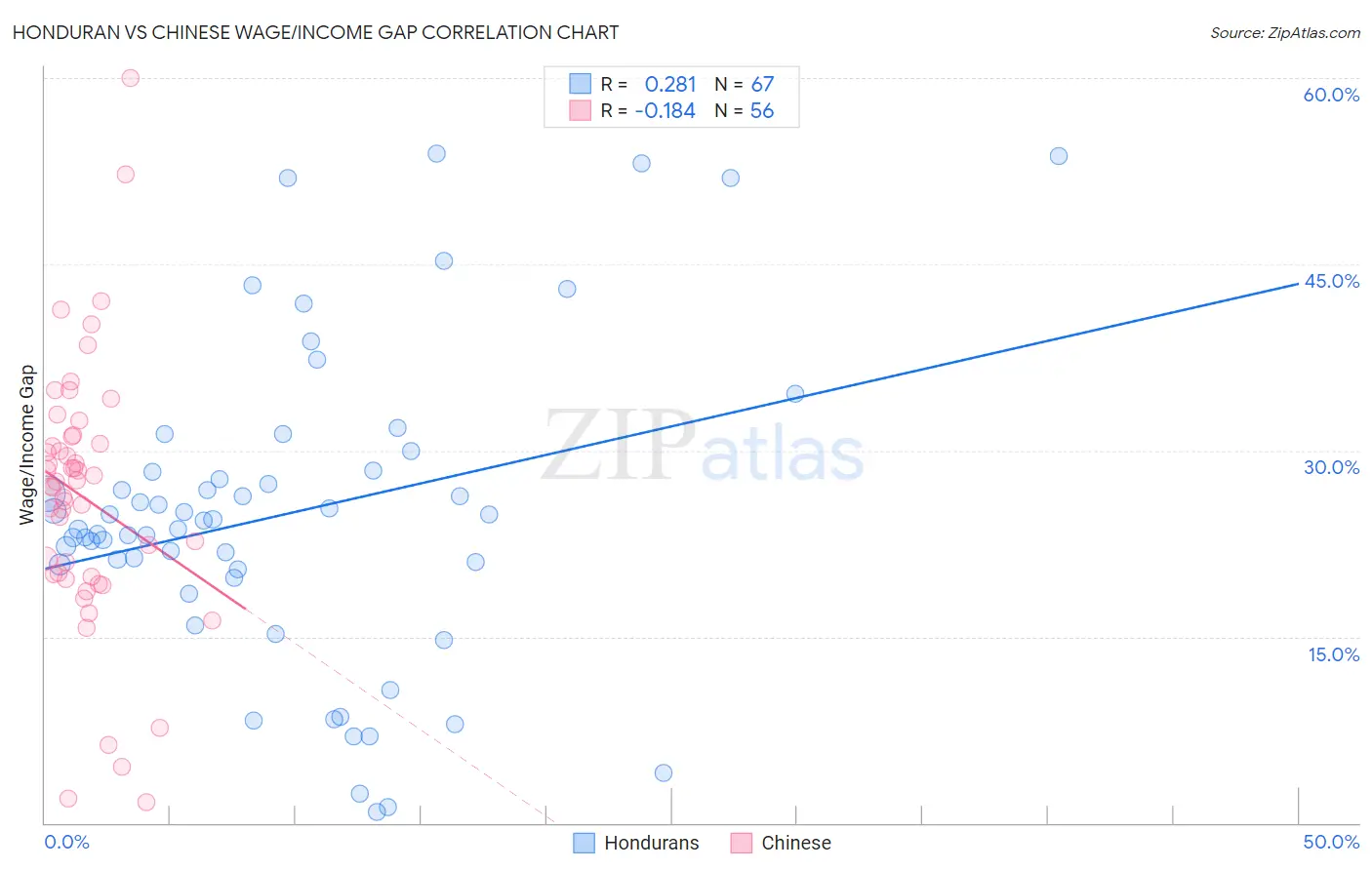Honduran vs Chinese Wage/Income Gap
COMPARE
Honduran
Chinese
Wage/Income Gap
Wage/Income Gap Comparison
Hondurans
Chinese
23.6%
WAGE/INCOME GAP
99.5/ 100
METRIC RATING
94th/ 347
METRIC RANK
25.9%
WAGE/INCOME GAP
42.0/ 100
METRIC RATING
178th/ 347
METRIC RANK
Honduran vs Chinese Wage/Income Gap Correlation Chart
The statistical analysis conducted on geographies consisting of 357,631,744 people shows a weak positive correlation between the proportion of Hondurans and wage/income gap percentage in the United States with a correlation coefficient (R) of 0.281 and weighted average of 23.6%. Similarly, the statistical analysis conducted on geographies consisting of 64,807,074 people shows a poor negative correlation between the proportion of Chinese and wage/income gap percentage in the United States with a correlation coefficient (R) of -0.184 and weighted average of 25.9%, a difference of 9.9%.

Wage/Income Gap Correlation Summary
| Measurement | Honduran | Chinese |
| Minimum | 0.90% | 1.7% |
| Maximum | 53.9% | 60.0% |
| Range | 53.0% | 58.3% |
| Mean | 25.0% | 26.2% |
| Median | 24.4% | 27.3% |
| Interquartile 25% (IQ1) | 20.4% | 19.9% |
| Interquartile 75% (IQ3) | 28.4% | 30.9% |
| Interquartile Range (IQR) | 8.0% | 10.9% |
| Standard Deviation (Sample) | 12.6% | 10.8% |
| Standard Deviation (Population) | 12.5% | 10.7% |
Similar Demographics by Wage/Income Gap
Demographics Similar to Hondurans by Wage/Income Gap
In terms of wage/income gap, the demographic groups most similar to Hondurans are Cape Verdean (23.6%, a difference of 0.030%), Immigrants from Cabo Verde (23.6%, a difference of 0.090%), Kiowa (23.6%, a difference of 0.15%), Immigrants from Sudan (23.6%, a difference of 0.24%), and Immigrants from Honduras (23.5%, a difference of 0.33%).
| Demographics | Rating | Rank | Wage/Income Gap |
| Yuman | 99.7 /100 | #87 | Exceptional 23.3% |
| Immigrants | Panama | 99.6 /100 | #88 | Exceptional 23.4% |
| Marshallese | 99.6 /100 | #89 | Exceptional 23.4% |
| Nicaraguans | 99.6 /100 | #90 | Exceptional 23.4% |
| Arapaho | 99.6 /100 | #91 | Exceptional 23.5% |
| Immigrants | Honduras | 99.5 /100 | #92 | Exceptional 23.5% |
| Immigrants | Cabo Verde | 99.5 /100 | #93 | Exceptional 23.6% |
| Hondurans | 99.5 /100 | #94 | Exceptional 23.6% |
| Cape Verdeans | 99.4 /100 | #95 | Exceptional 23.6% |
| Kiowa | 99.4 /100 | #96 | Exceptional 23.6% |
| Immigrants | Sudan | 99.4 /100 | #97 | Exceptional 23.6% |
| Immigrants | Latin America | 99.2 /100 | #98 | Exceptional 23.7% |
| Aleuts | 99.2 /100 | #99 | Exceptional 23.7% |
| Yakama | 99.2 /100 | #100 | Exceptional 23.7% |
| Japanese | 99.1 /100 | #101 | Exceptional 23.8% |
Demographics Similar to Chinese by Wage/Income Gap
In terms of wage/income gap, the demographic groups most similar to Chinese are Cambodian (25.8%, a difference of 0.21%), Samoan (26.0%, a difference of 0.23%), Guamanian/Chamorro (26.0%, a difference of 0.27%), Paraguayan (25.8%, a difference of 0.32%), and Sri Lankan (25.8%, a difference of 0.33%).
| Demographics | Rating | Rank | Wage/Income Gap |
| Immigrants | Greece | 56.6 /100 | #171 | Average 25.7% |
| Immigrants | Chile | 53.2 /100 | #172 | Average 25.7% |
| Immigrants | Belarus | 52.9 /100 | #173 | Average 25.7% |
| Alaskan Athabascans | 50.0 /100 | #174 | Average 25.8% |
| Sri Lankans | 47.0 /100 | #175 | Average 25.8% |
| Paraguayans | 46.7 /100 | #176 | Average 25.8% |
| Cambodians | 45.1 /100 | #177 | Average 25.8% |
| Chinese | 42.0 /100 | #178 | Average 25.9% |
| Samoans | 38.6 /100 | #179 | Fair 26.0% |
| Guamanians/Chamorros | 38.0 /100 | #180 | Fair 26.0% |
| Immigrants | Bolivia | 36.4 /100 | #181 | Fair 26.0% |
| Immigrants | Serbia | 35.4 /100 | #182 | Fair 26.0% |
| Immigrants | Kazakhstan | 35.2 /100 | #183 | Fair 26.0% |
| Mexicans | 34.4 /100 | #184 | Fair 26.0% |
| Pakistanis | 33.7 /100 | #185 | Fair 26.1% |